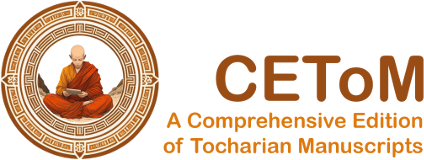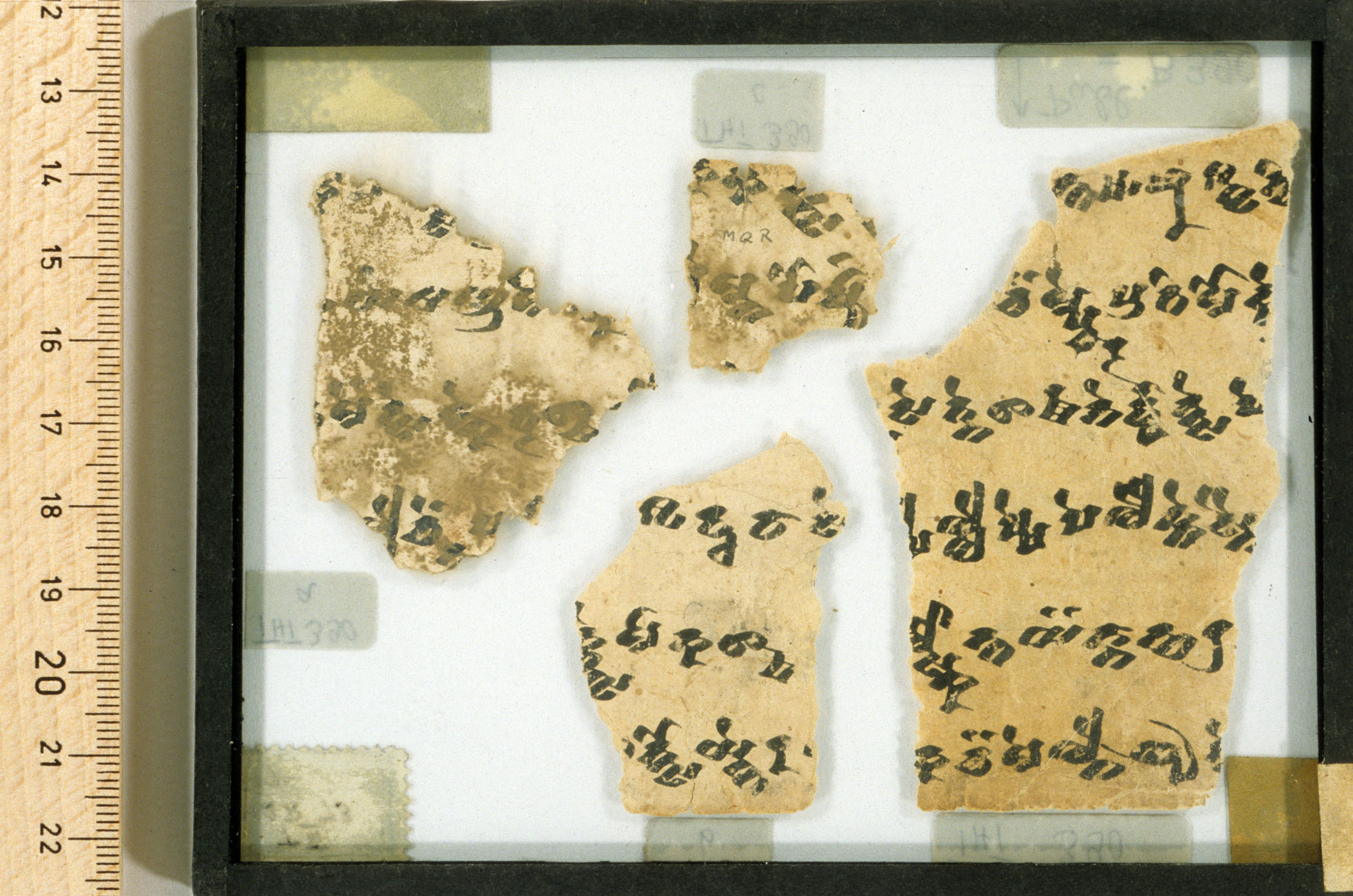THT 390
| Known as: | THT 390; B 390; prelim. no. Toch 421 |
|---|---|
| Cite this page as: | "THT 390". In A Comprehensive Edition of Tocharian Manuscripts (CEToM). Created and maintained by Melanie Malzahn, Martin Braun, Hannes A. Fellner, and Bernhard Koller. https://cetom.univie.ac.at/?m-tht390 (accessed 09 Jul. 2025). |
Provenience | |
| Main find spot: | Kizil Ming-öy |
| Expedition code: | T III MQR 73 |
| Collection: | Berlin Turfan Collection |
Language and Script | |
| Language: | TB |
| Linguistic stage: | archaic |
| Script: | classical |
Text contents | |
| Title of the work: | Buddhacarita (not by Aśvaghoṣa) |
| Text genre: | Literary |
| Text subgenre: | Kāvya |
| Verse/Prose: | verse |
| Meter: | 543 (4x) |
Object | |
| Manuscript: | THT 388-390 |
| Material: | ink on paper |
| Form: | Poṭhī |
| Number of lines: | 8 |
Images
Images from idp.bbaw.de by courtesy of the International Dunhuang Project Berlin, the Berlin-Brandenburgische Akademie der Wissenschaften, and the Staatsbibliothek zu Berlin – Orientabteilung.
Transliteration
| a1 | /// [ṣ]ṣ· ntse nke lle ste /// |
|---|---|
| a2 | /// ta ṅwsa wä rpā te cme /// |
| a3 | /// [ñ]ñ· o ṅkro ce ce wī ke [n]· /// |
| a4 | /// ·ta rko ṣce pu dñä kte lkā /// |
| a5 | /// [10] [3] tu meṃ su tsa /// |
| a6 | /// [s]·ā sa rsa [wä] /// |
| b3 | /// nta 10 8 śwa t[s]i /// |
| b4 | /// cä mpce¯ ¯r pra ti mo k[ṣn]e /// |
| b5 | /// se tne s̝a rma ne rvvā ntse pe /// |
| b6 | /// lp[e] lle ṣṣe pe lai kne snai /// |
| b7 | /// lsko nta yä knā nta rra /// |
| b8 | /// ka cä me lne ñyā [t]·e /// |
Transcription
| 13d | (śai)ṣṣ(e)ntse nkelle ste /// a2/// täṅwsa wärpāte cme /// a3/// ññ· oṅkroce cew īken(e) /// a4/// ·tärkoṣ ce pudñäkte lkā /// a5/// 10-3 |
|---|---|
| 18d | tumeṃ su tsä /// a6/// s·āsarsa wä /// b3/// nta 10-8 |
| * | śwatsi /// |
|---|---|
| b4 | /// cämpcer pratimokṣne /// |
| b5 | /// se tne ṣärmä nervvāntse pe /// |
| b6 | /// (tsä)lpelleṣṣe pelaikne snai /// |
| b7 | /// (pä)lskonta yäknāntär ra /// |
| b8 | /// ka cämelne ñyāt(s)e /// |
Commentary
Remarks
| In general, the script type is standard with only very few still archaic-shaped signs; cf. Malzahn 2007a: 265. |
Alternative linguistic/paleographic classifications
| Peyrot 2008 | A2 |
| Malzahn 2007a | A5 |
| Tamai 2011 | C1 |
| Tamai 2011 | C14 |
References
Online access
Edition
Translations
Thomas 1952: a1 (59)
Bibliography
“The International Dunhuang Project: The Silk Road Online.” n.d. http://idp.bl.uk.
Malzahn, Melanie. 2007a. “The most archaic manuscripts of Tocharian B and the varieties of the Tocharian B language.” In Instrumenta Tocharica, edited by Melanie Malzahn, 255–97. Heidelberg: Winter.
Peyrot, Michaël. 2008. Variation and change in Tocharian B. Vol. 15. Leiden Studies in Indo-European. Amsterdam/New York: Rodopi.
Sieg, Emil, and Wilhelm Siegling. 1953. Tocharische Sprachreste. Sprache B, Heft 2. Fragmente Nr. 71-633. Edited by Werner Thomas. Göttingen: Vandenhoeck & Ruprecht.
Tamai, Tatsushi. 2011. Paläographische Untersuchungen zum B-Tocharischen. Innsbrucker Beiträge zur Sprachwissenschaft 138. Innsbruck: Institut für Sprachen und Literaturen.
Thomas, Werner. 1952. Die tocharischen Verbaladjektive auf -l. Deutsche Akad. der Wissenschaften zu Berlin, Institut für Orientforschung 9. Berlin: Akademie-Verlag.
Gippert, Jost, Katharina Kupfer, Christiane Schaefer, and Tatsushi Tamai. n.d. “Thesaurus Indogermanischer Text- und Sprachmaterialien (TITUS): Tocharian Manuscripts from the Berlin Turfan Collection.” http://titus.fkidg1.uni-frankfurt.de/texte/tocharic/thtframe.htm.




